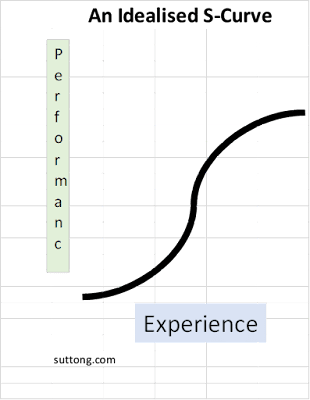Students in many fields learn that relationships between variables may be described as a simple one-to-one correspondence or linear. We often see tables of correlations in journal articles and presentations. Unless otherwise stated, the correlations appear to assume a linear relationship exists. As one variable increases so does the other or as one variable increases, the other declines.
But we also learn that some relationships are nonlinear such as the forgetting curve (remember Ebbinghaus) or the learning curve depicted as an S-shape.
The classic learning curve illustrates the relationship between learning and experience and
is often presented as an S-curve. At first, progress is slow—the curve of
learning rises a little. Then, with experience, learning rises rapidly up to a
point when it seems to level off at a person’s level of proficiency. This curve
has many names such as progress curve, startup curve, and experience curve.
However, we should follow the data rather than assume a learning curve is applicable. Perhaps there is no relationship or another curve is a better fit.
 |
| A curve I drew in Excel |
Reference for using scales in research:
Buy Creating Surveys on

Reference for clinicians on understanding assessment
Buy Applied Statistics for Counselors

NOTICE:
The information about scales and measures is provided for clinicians and researchers based on professional publications. The links to authors, materials, and references can change. You may be able to locate details by contacting the main author of the original article or another author on the article list.
Post Author
Geoffrey W. Sutton PhD is Emeritus Professor of Psychology who publishes book and articles about clinical and social psychology including the psychology of religion. Website: www.suttong.com
Books available on AMAZON and the GOOGLE STORE
Connections
FACEBOOK Geoff W. Sutton
TWITTER @Geoff.W.Sutton
PINTEREST www.pinterest.com/GeoffWSutton
Read many published articles and book samples on:
Academia Geoff W Sutton
ResearchGate Geoffrey W Sutton
Comments
Post a Comment